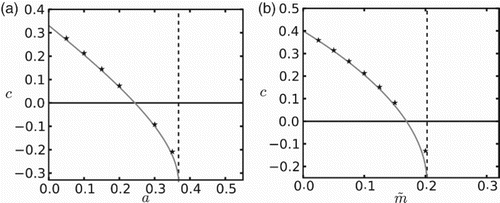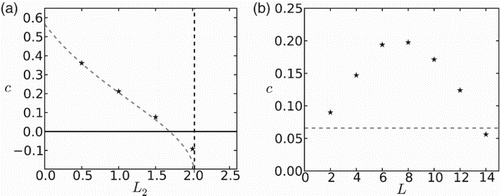Figures & data
Figure 1. Rates of spatial spread in a heterogeneous environment as a function of the Allee effect threshold in ‘favourable’ patches (a) and the mortality rate in ‘unfavourable’ patches (b). Vertical lines indicate threshold values for c to be real, as obtained from Equation (Equation26(26)
(26) ). Other parameters are:
,
and
. We consider no habitat preference, i.e.
. Furthermore,
in (a) and
in (b).

Figure 2. Speed of invasion as a function of diffusion coefficient in ‘unfavourable’ patches. Gray and black lines are obtained using continuous and discontinuous interface conditions, respectively. Numerical calculation of speeds are represented by stars. Fixed parameters are: ,
,
,
and
.

Figure 3. Dependence of the speed of invasion on the patch sizes. (a) c is a monotonically decreasing function of . (b) Numerical calculations (stars) show a non-monotonic dependence of c on the spatial period
, while analytical approximation for c (Equation (Equation25
(25)
(25) )) (gray line) shows no dependence on L when a fixed ratio between
and
is set. Parameter values are
,
and
in (a), and
,
and
in (b). The vertical line in (a) indicates the threshold above which c becomes complex, as obtained from Equation (Equation26
(26)
(26) ). We consider no habitat preference (
) and equal movement rates (
).

Figure 4. The effect of bias towards ‘favourable’ patches on the speed of invasion. The gray dashed curve is drawn from Equation (Equation25(25)
(25) ); stars are obtained from numerical solutions. The vertical line shows the threshold habitat preference obtained from Equation (Equation26
(26)
(26) ). Fixed parameters are:
,
,
and
.

Figure 5. (a) Homogenized carrying capacity (; gray line) and Allee threshold (
; black line) as a function of movement rates (D) in unfavourable patches. In this case the population experiences a strong Allee effect in both patch types, with strengths
.
in this figure. (b) Invasion speed as a function of D. Lines are the approximated speeds obtained from homogenization (Equation (Equation38
(38)
(38) )) and stars are obtained from numerical simulations. The gray line corresponds to
and the black line to
. In both figures discontinuous interface conditions are used. Other parameters are:
,
,
and
.

